A statistics calculator lets you solve complex equations with dedicated functions and buttons. For any discipline that involves calculations like math, algebra, trigonometry, geometry, statistics, and engineering, solving a problem manually costs them much time and energy.
In such a situation a well-programmed calculator can make your life easier. Nowadays calculators have been upgraded in functions. A device that can help with multiple tasks at a time will be the best choice to go for.
In this article, we have listed some top recommended items used for the solution of statistical problems.
The Best Statistics Calculators to Buy
1. Texas Instruments TI-83 Plus for Statistics – Overall Pick
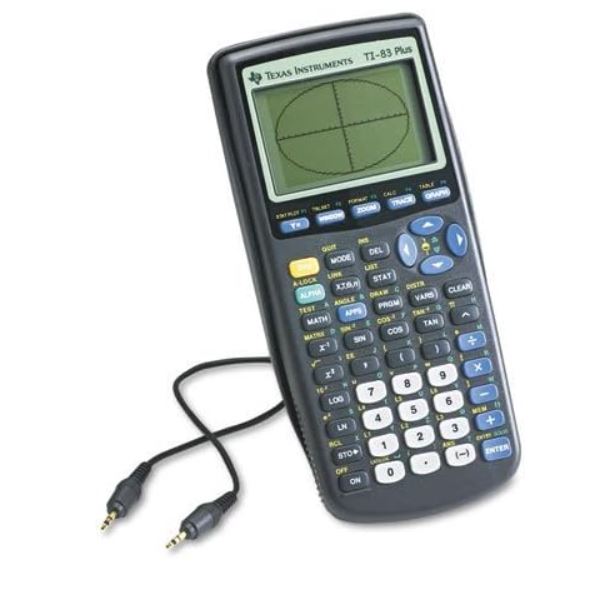
It is a valuable unit for the students of STEM and has remained a popular and durable device among students of high school and college. The unit is a mixture of basic and advanced functions of statistics.
With its ample memory, one can work with lengthy calculations without even clearing the screen. It’s a reliable calculator to with if you are attempting ACT or SAT exam.
When it comes to functions it offers the most demanding built-in functions like data analysis, regression, probability and hypothesis testing, and much more.
The Texas Instruments TI-83 Plus packs more functions when compared with the Ti-36X Pro from the same brand.
Features
- The device comes with dimensions of 7.3 x 1 x 3.5 inches.
- It offers a readable display of 64 x 96 pixels, 8 x 16. It has 24KB RAM and 160KB Flash ROM memory.
- It is supported by 4 AAA batteries and a lithium metal battery to support ROM memory.
- The unit is handy and weighs 8 ounces.
- It is capable of displaying 12 characters per eight lines.
- One can transfer and share the data via its I/O port.
- It allows software updates.
- It can evaluate real and complex numbers with up to ten-digit accuracy.
- With its multiple graphing functions it can draw and compare graphs in six different styles including histogram, scatter, XY coordinates, etc.
- It has 15 probability functions like normal, t-student, binomial, and Poisson.
- It also provides advanced tools for statistics, graphic data analysis, engineering, finance, logarithm, trigonometry, and hyperbolic functions.
- It gives you a better view of equations, graphs, and coordinates simultaneously.
- Apps like Science Tools, Study Cards™, Probability Simulation, and Venire Easy Data are pre-installed on the device.
Pros
- The gadget is budget-friendly as compared to other Ti models.
- The device comes with rechargeable batteries.
- It comes with an easy-to-use interface.
- The split screen allows you to rotate the graph in vertical and horizontal positions.
- It supports the latest software updates.
Cons
- The system updates as per the storage capacity of the device.
2. Texas Instruments TI-84 Plus Graphic Calculator for Advanced Statistics: Best Value Pick

The device is an accumulation of advanced graphing and mathematical tools. Expanded graphing functions like interactive geometry, inequality graphing, and real-world data collection are made part of its design.
Besides, it is pre-loaded with different mathematical, calculus, and statistical functions. Twelve Apps are pre-loaded, Graphing, including Cabri Jr., CBL/CBR, Conic Graphing, Inequality Graphing, Probability Simulations, Science Tools, Study Cards, Timespan, Transformation more.
For students in math and sciences, the TI-84 Plus as compared to Casio’s FX-9750GIII is a remarkable problem solver with features for storing, graphing, and analyzing up to 10 functions.
Additionally, it allows you to display graphs and evaluate tables on a split screen horizontally and vertically.
Features
- It comes in the dimensions of 7.8 x 6.06 x 1.34 inches, with a resolution power of 64 × 96. The feature enables it to display 16 characters per eight lines.
- It helps you to trace the graph and scroll through table values simultaneously via its split-screen function.
- With its special command, it can solve matrices using functions such as determinant, Ad joint, and row-column.
- It is able to do statistical analysis. Functions like mean median and mode, logarithms, cubic polynomials, and quadratic polynomials can be better analyzed.
- Math print technology in this unit engages the student’s focus as it provides a proper format to enter the fractions and equations.
- Ti 84 Plus is powered by four AAA batteries.
- The unit provides enough storage of 480 KB ROM and 24 K RAM and can store and upload up to ten functions simultaneously.
- The unit is capable of solving the negative of a complex number that leads to syntax error when compared with its competitors.
- The backlit screen feature in the device allows you to adjust the brightness according to your vision.
- It includes a slide case to resist any damage to the device.
Pros
- The unit is intuitive and easy to use.
- Ti 84 Plus has a two times faster processor than its previous versions.
- It can entertain the negative of a complex number.
- The product is durable.
- It can save and compare up to ten graphing functions at a time
Cons
- Self-programming of the calculator needs expert help.
3. Texas Instruments TI-84 Plus CE Color Graphing Calculator for Descriptive and Inferential Statistics
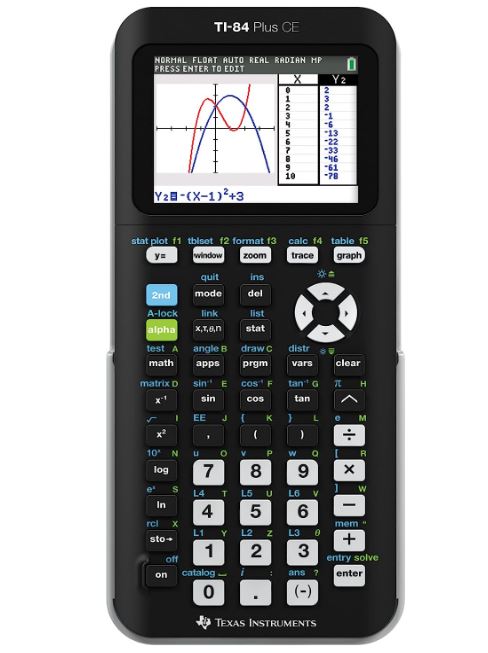
This successor version of the Ti 84 plus calculator has commendable features. From a faster processor to a high-resolution screen Ti has amazed its users as always.
Unlike the previous models, it can cater to the needs of students studying in various disciplines.
What differentiates it from the previous models is its high-resolution screen, powerful RAM, enhanced graphing capabilities, rechargeable battery, and much more.
The i/o port in the device allows it to update and install the software and share or transfer data to other supporting devices. It’s the most highly recommended calculator for SAT and other competitive exams.
Features
- The product comes in the dimensions of 7.5H x 3.42 Wx 0.62 inches.
- It is sleek and has an average weight of 7 ounces.
- The problem solver has 3.0MB ROM / 154K RAM which is more than enough to run and save multiple tasks at the same time.
- It has a high resolution of 140DPI 16-bit color screen. This vibrant feature not only enhances the readability of the screen but also makes faster connections between data, equations, and graphs.
- It is powered by a lithium metal battery which is included in the package.
- The product has pre-loaded apps like graphing, including Cabri Jr., CBL/CBR, Conic Graphing, Inequality Graphing, Probability Simulations, Science Tools, Study Cards, Timespan, unit conversions, and more.
- For descriptive and inferential statistics the unit has an app to calculate mean, median, mode, standard deviation, real data analysis, and probability problems.
- Math print view visualizes the digits, symbols, and formulas exactly as they appear in textbooks.
- For the students of statistics, it can be a time saver as it has the capability to plot and display graphs in six different styles.
- It can graph 9 different equations simultaneously.
- The grid lines are drawn in different colors to differentiate one from another which makes them easy to read.
- It can compute the binomial coefficient factorial and binomial commutative distribution function.
- With its special command, it can solve matrices using functions such as determinant, Ad joint, and row-column.
- Math print technology in this unit engages the student’s focus as it provides a proper format to enter the fractions and equations.
- The unit is approved for use on SAT, ACT, AP exams, IB exams, etc.
Pros
- The keyboard has a firm hold.
- The backlit screen allows you to adjust the contrast according to day and night.
- The rechargeable battery can work for up to a month if used occasionally.
- USB port in the device helps to communicate and transfer data to other devices.
- It comes with a detailed user guide.
- It supports all Ti 83 apps.
Cons
Students complain that the product comes with a hefty price tag.
4. Casio fx-115ES PLUS 2nd Edition Calculator for Statistics
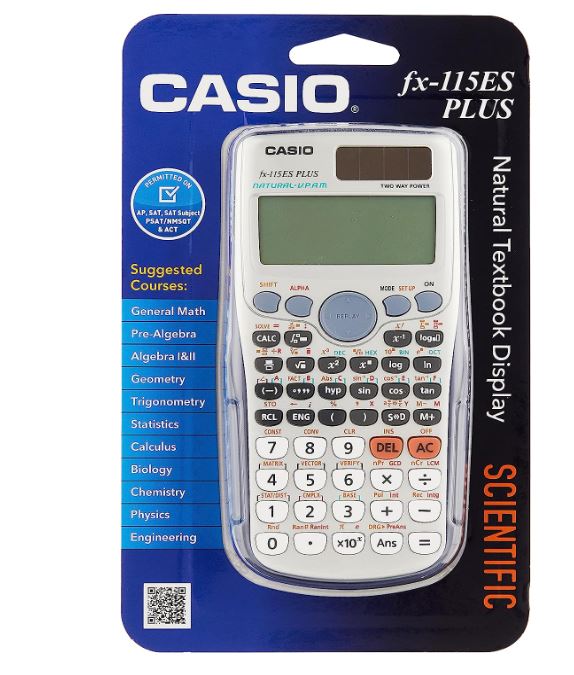
The unit is the most widely used device among high school and college-going students. It can cater to the needs of students studying statistics, algebra, trigonometry, math, physics, and various others.
As a statistics problem solver it possesses basic and advanced statistical functions like list-based STAT data editor and distribution calculations etc. Above all you get tons of features in this unit without even disturbing your budget.
The unit comes in dimensions of 5.5 x 2 x 9 inches. It is easy to carry and has an average weight of 6.1 ounces. What differentiates it from the previous versions is its dual power source which is 1 LR44 battery and improved solar operation.
Features
- Its natural textbook display offers a clear display and also allows the students to enter the digits in proper math format.
- The device can store up to nine variables.
- One can adjust the brightness of the screen as per requirement.
- The numerical digits on the keyboard are colored grey on white whereas the function keys are painted white on black which makes them easily readable.
- Navigation buttons allow you to scroll and edit the values during the calculations.
- Two-way power sources of the unit make it more appealing to choose from.
- A protective hard case prevents the calculator from any external damage.
- The device is pre-loaded with more than 252 functions including inequality calculations, and expression equality checks.
- Other than that the device has the capacity to find exact squares, roots, derivatives, and Number of Absolute Value Calculations, Power Function Cube, Inverse Trigonometric Functions, Hyperbolic / Inverse Hyperbolic Functions, Exponential Calculation, Logarithmic Calculation, Log not base 10, Coordinate Conversion, Combination / Permutation, Prime Factorization, GCD / LCM, Determine the Integer Part, Random Number Generation, Random Integer Generation, Summation, Product Calculation, etc.
- It has a special function to revive previous answers.
- The product is capable of performing statistical functions like mean, median, mode, standard deviation, etc.
- This unit is heat resistant.
Pros
- The battery comes with 3 years warranty.
- It is a budget-friendly gadget with a pack of useful functions that work for STEM subjects.
- A comprehensive how-to-use key is included inside the box.
Cons
- It has a limit to the operating negative of complex numbers.
- The calculator is non-programmable.
- It loses its history once restart.
5. Texas Instruments TI-34 Multi View Calculator for Statistics
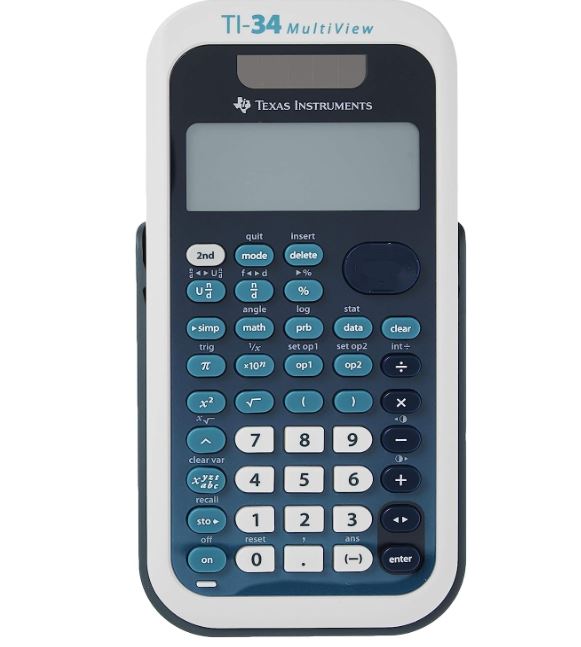
The product is flooded with some remarkable features for the disciplines of Statistics, math, Pre-Algebra, Algebra 1 and 2, General Science, and Geometry.
For statistics, it helps you to work with two variables at a time. The device is capable of evaluating problems of variance, mean, median standard deviation, etc.
Features
- The unit comes in dimensions of 6.65 x 0.87 x 3.31 inches and weighs 4.8 ounces.
- The four lines large four-line LCD allows you to insert 16 characters and then process and modify calculations on the same page.
- Similarly, the math print feature allows the students to concentrate more on the work as it helps them to insert the values in proper math notation.
- Like other upgraded Ti models, this gadget is backed by batteries and solar power.
- Through its previous entry feature, you can review the previous calculations easily.
- It has 247 built-in functions in total.
- A simple interface is designed that is easily understandable by users of any age.
- Functions can be easily searched and placed in a single location.
- It has seven independent memory variables that help you to convert and compare the calculations.
- Above all, it works best for the conversion of fractions, constant operations, percent, decimal conversions, and scientific notation.
Pros
- It is the best device with a fusion of basic and intermediate-level functions.
- It is reliable.
- It is lighter in weight.
Cons
- It cannot be used for advanced-level studies.
- The keypad has a wobbly touch.
6. HP 35S Programmable Calculator for Business Statistics

It is one of the best programmable scientific calculators that can do wonders for students of statistics. The product comes in the dimensions of 6.2 x 3.2 x 0.7 inches. It is handy and weighs 4.8 ounces.
The device can be switched to RPN as well as algebraic entry system logic as per the requirement of the data.
Its 16-character large display allows you to enter and process a large set of data on the same screen simultaneously. With enough memory, it can deal with the heaviest set of data in the shortest possible time.
It is powered by two metal lithium batteries. The device has more than a hundred built-in functions and a complete set of unit conversions.
Features
- The problem solver has pre-installed 100 functions including unit conversions, constant evaluation, variance, median, mean, mode, standard deviation, and various other statistical functions.
- To work on a large set of data it has a permanent memory of 30 KB with 800 independent variable storage spaces.
- It can be taken on any professional exam where the blue tooth and Wi-Fi connectivity are prohibited.
- It is among those three calculators that are allowed by professional exam authorities despite its programming capabilities.
- Its alpha-numeric display allows you to enter algebraic values along with their variables.
- Its navigation keys help you to scroll the cursor around data for editing to get accurate results.
- Its 2-line large display can preview 16 characters at a time.
- A carrying case is included in the package to protect the unit from wear and tear.
- Unlike others, this device uses RPN reverse polish notation so that you can put data without putting parenthesis or round brackets.
- The device contains all the general functions of a scientific calculator such as square, square roots, sin, cos, tan,
- The adjustable contrast option allows the user to fix the lighting of the screen as per the requirement of day and night light.
Pros
- Its interface is student-friendly and easily understandable.
- The use of the RPN function makes sure to avoid any context or prompt error.
- An instruction guide is placed in the box to help the user master the device.
Cons
- Programming needs some expert help.
- The unit has a single power source.
- It lacks advanced functions and can be used by basic and middle-level students.
7. Sharp EL-W516XBSL 556 Scientific Calculator
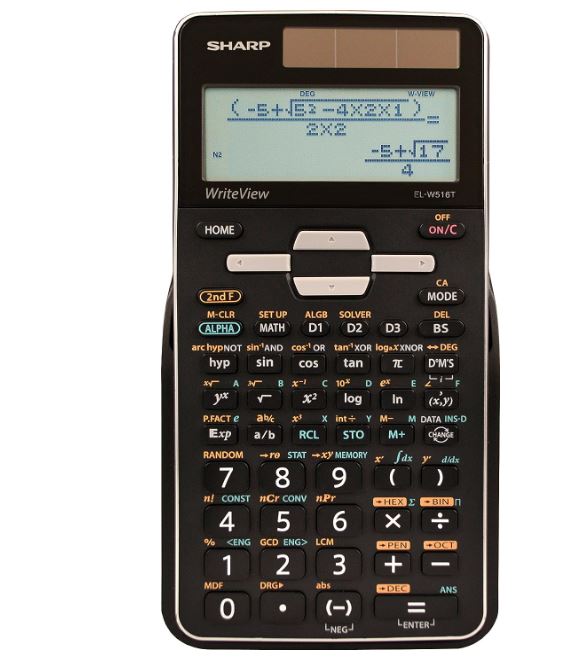
Sharp has always remained one step forward in the provision of updated technology. It has designed the devices paying heed to the needs of students of all levels and disciplines. Sharp EL-w516 can perform more than 500 scientific and mathematical functions.
The write-view technology in the device previews data similar to that of the textbook. It can perform in four different modes and statistics is among them.
The device comes with an easy user interface so the user can switch to the desired mode easily. This calculator is handy and is powered by dual sources.
It has been approved for various tests including AP Chemistry, AP Physics, PSAT/NMSQT, SAT I, SAT II, Math IC, and Math IIC.
Features
- The unit comes with dimensions of 9.6 x 5.8 x 1 inches and weighs 7.2 ounces.
- It has a considerably large 4-line display that allows you to enter 16 characters at a time.
- The problem solver has the ability to solve three equations simultaneously.
- It can solve factorials, quadratic formulae, mathematical functions, and much more.
- Its four programmable keys can be used as independent storage spaces for quicker access to desired or most-used functions.
- It can work in four different Modes – Normal, Stat, Drill, Complex, Matrix, List, and Equation.
- Statistical functions included in this package are permutations and combinations, mean, median, mode, range, polynomials, derivatives, and matrices.
- You can access previous solutions while searching history from its manual.
- It contains a number of math, scientific, trigonometric, stat, and science functions. A few of them are given below. Log, In, 10x, eX, Log_ax, sinh, cosh, tanh, sinh-1, cosh-1, tanh-1, n! ,nCr, cPr, RANDOM, DEG, RAD, GRAD [DRG], -> r8, ->xy, >DEG, >RAD,>GRAD [DRG], abc
- With its dual power source which is batteries and solar, you need not worry about any uncertain conditions.
Pros
- It is a budget budget-friendly gadget.
- It is relatively cheap compared to its competitors.
- It is best for beginners.
- The unit has programmable keys.
Cons
- It cannot handle heavy workloads.
Factors to Consider When Buying A Calculator for Statistics
1. Functionality and Features
When selecting a calculator for statistics, consider its functionality and the specific features it offers. Look for essential statistical functions like mean, median, mode, standard deviation, variance, and probability distributions.
Advanced functions such as regression analysis, hypothesis testing, and confidence intervals can be crucial for more complex statistical tasks.
2. Data Entry and Storage
Efficient data entry and storage capabilities are essential. Ensure the calculator allows you to input and manipulate datasets easily. Look for options to store multiple datasets, variables, and user-defined lists or matrices for convenient data management.
3. Display and Readability
The calculator’s display is crucial for readability and usability. Choose a calculator with a clear and legible screen that can handle complex equations and statistical results without causing confusion. Consider factors like screen size, resolution, and the ability to display graphs or charts.
4. Data Visualization
Data visualization can aid in understanding statistical concepts. Opt for a calculator that can generate histograms, scatter plots, box plots, and other graphical representations of data. Graphical capabilities can help you interpret and communicate statistical findings effectively.
5. User-Friendly Interface
An intuitive and user-friendly interface is essential, especially if you are new to statistics. Look for calculators with menus, shortcut keys, and a logical layout that simplifies navigation and minimizes errors during calculations.
6. Memory and Programming
Memory capacity is critical for storing data, formulas, and programs. Ensure the calculator has sufficient memory to handle your statistical projects. Additionally, the ability to create and run custom programs can be advantageous for automating repetitive calculations or complex statistical procedures.
7. Power Source and Durability
Consider the power source of the calculator, whether it uses batteries, solar panels, or a combination of both. Evaluate the calculator’s build quality and durability, especially if you plan to use it extensively or in challenging environments.
8. Compatibility and Connectivity
Check if the calculator is compatible with other devices or software. Some calculators allow data transfer to and from computers or other calculators, making it easier to collaborate or share data. Connectivity options like USB or Bluetooth can be beneficial.
9. Exam Approval
If you intend to use the calculator for standardized tests or exams, ensure it is approved for such purposes. Many exams have specific guidelines regarding calculator models and functionalities that are allowed.
10. Cost and Warranty
Consider your budget and the value offered by the calculator. While advanced features are desirable, they often come at a higher cost. Additionally, check for warranties and customer support to ensure your investment is protected.
Conclusion
For statistics, all you need is a calculator that accepts numerical values along with alphabets. A scientific calculator can work for basic-level statistics.
In my opinion, the Texas Instruments TI-83 Plus calculator gives you the most value for your money when it comes to solving advanced-level statistical equations.
However, if you want to deal with graphical data you must spend your money in a graphical calculator. Investing your money wisely in durable devices like these is not a bad option.
To provide you clarity of mind we have tried our best to briefly explain the features of the problem solvers used for statistics. The products are explained with both negative and positive aspects.
All of them have some unique features which differentiate them from one another. So you can choose the one that fits your budget and needs.
FAQS
Which type of calculator is needed for statistics?
Well, you can solve statistics using a scientific calculator, but for the evaluation of graphical data and real data analysis, you need a device with graphing capabilities.
What are the features to be considered while buying a calculator for advanced statistics?
You must consider that it has STAT mode in it. From its user manual check if it can perform functions like mean, median, mode, standard deviation, etc.
Secondly, it must allow alpha-numeric values inserted together. Check the graphing features the device can perform.
Which type of calculator is allowed in Aptitude tests?
A unit that does not support Bluetooth or WIFI is approved by authorities. Other than that some of the devices from the TI series are also allowed for tests like SAT and AP tests etc.
.

Sheema Ahmed is a passionate writer and educator, specializing in crafting content tailored for individuals preparing for challenging exams such as CSS, SAT, and ACT. Born with a fervour for education, Sheema’s journey began at Hazara University, where she graduated with distinction, solidifying her commitment to academic excellence.
